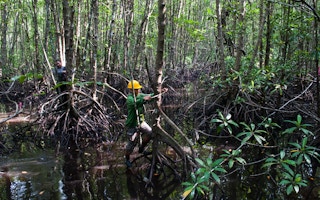As the risks of sea level rise, stronger tropical storms and seawater intrusion grow due to climate change, Indonesia is ramping up efforts to protect mangrove ecosystems across the archipelago as part of both its Covid-19 recovery efforts and climate change commitments.
Currently, Indonesia has about 3.2 million hectares of mangroves. The goal is to rehabilitate 150,000 hectares of degraded mangrove this year, and a total of 600,000 hectares by 2023. The effort is being led by Indonesia’s coordinating minister for maritime affairs, Luhut Binsar Pandjaitan, and the Ministry for Environment and Forestry, with support from the World Bank and local NGOs.
“The government of Indonesia has taken several bold initiatives to protect and restore critical coastal ecosystems, particularly coral reefs and mangroves,” said Andre Aquino, senior natural resources management specialist at the World Bank’s environment and natural resources global practice, during an online press event.
Indonesia has about 23 per cent of the world’s mangroves, and they store an estimated 3.14 billion metric tonnes of carbon, according to the World Bank. The figure used to be much higher, however. Nearly 1 million hectares of mangroves have been lost in the country since 1800.
While coal power plants, ports and other infrastructure development have all played a part, the main factor has been growth in shrimp farms. Top export destinations for Indonesian shrimp include the United States, Japan and China.
In charge of rehabilitation and restoration is the newly named Peatland and Mangrove Restoration Agency. Its predecessor, the Peatland Restoration Agency (PRA), was formed in 2015 after Indonesia experienced historical forest fires connected to peatland degradation.
The PRA has restored more than 1 million hectares of peatland so far. Now, the agency is aiming to restore a further 2 million hectares of degraded peatland and mangrove ecosystems across 13 provinces, partly funded by the growing carbon market.
“Sustainable mangrove management is going to be part of ensuring that Indonesia is a carbon superpower,” said Nirarta ‘Koni’ Samadhi, director of World Resources Institute (WRI) Indonesia. “Indonesia can sell carbon credits to the market, which would then feed into the state budget.”
According to WRI Indonesia, mangrove forests have been lost at a higher rate than Indonesia’s inland tropical forests, despite the latter getting far more attention. This has resulted in a decline in fisheries health, more soil erosion and greenhouse gas emissions, as soil carbon escapes into the atmosphere where mangroves are cut down or killed. With so many drivers pushing mangrove loss, protection and restoration will be a challenge.
“If you want to successfully restore mangroves, it has to be connected to livelihood programs, and that will take quite some time,” said Nirarta. “It is not an easy task.”
The World Bank’s effort aims to take a livelihood approach, which includes investing in basic services and infrastructure that improve the quality of life of people who live on the coasts. They also want to ensure that communities play an active role in mangrove restoration and management.
“Working with the local communities is going to be a key part of these reforms,” said Mari Elka Pangestu, World Bank’s managing director of development policy and partnerships, during a press event. “This is what green and blue, resilient, inclusive development is all about.”
One particular challenge is data and maps, especially when trying to determine where to focus restoration efforts.
Nirarta notes that the official numbers are estimates, and lack the details necessary to implement restoration efforts. “We don’t have good and reliable maps on mangroves.”
This was the case with peatlands back in 2015, and led to efforts including a Peat Mapping Prize, to improve the use of data, satellite technology and drones to accurately map peatlands and their carbon stock. Nirarta hopes that similar efforts can help scale up mangrove restoration quickly and effectively.
Both Nirarta and the World Bank hope that, if successful, mangrove restoration can play a key role in both Indonesia’s climate commitments, and resilience efforts. Restoration would reduce greenhouse gas emissions, and go a long way towards meeting the country’s Paris Agreement commitments, which are highly dependent on reducing land-based emissions.
It would provide greater resilience to sea level rise and extreme weather events, such as the floods that killed over 100 in East Indonesia in April. And it can be a model for other mangrove-rich tropical nations.
“Managing the oceans sustainably is a global issue, and as the world’s largest archipelago nation, Indonesia can play a leading role,” said Pengestu.
This article was originally published on China Dialogue under a Creative Commons licence.










